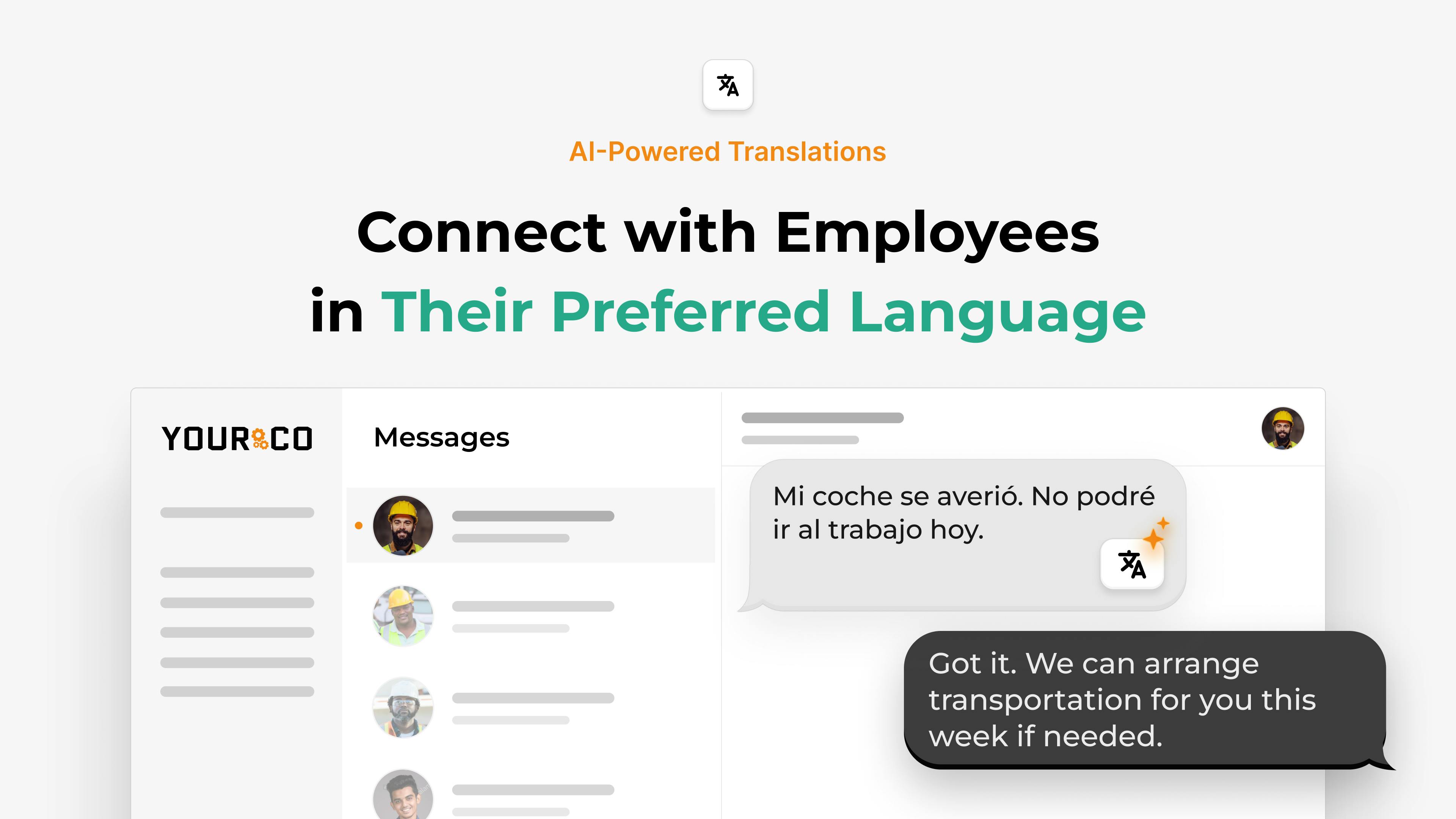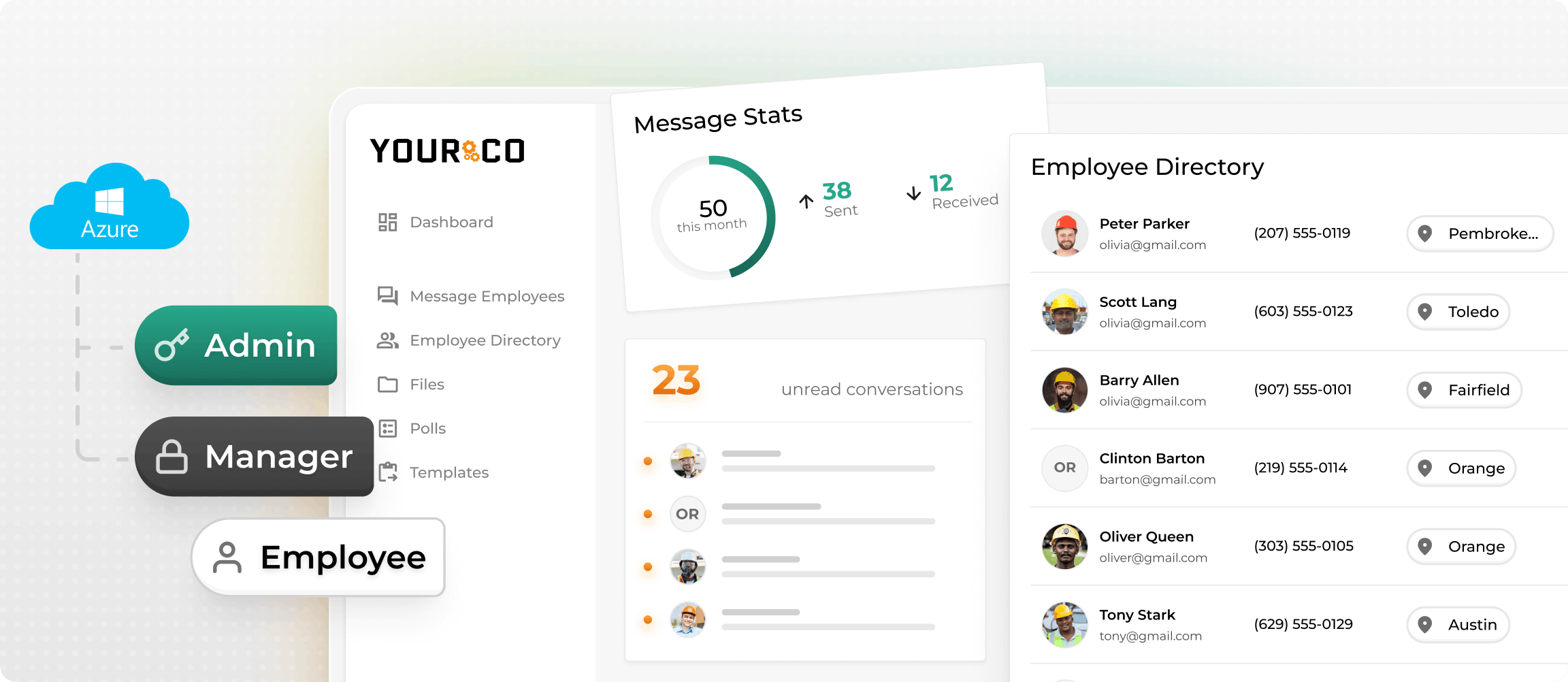Free Onboarding Templates in Chinese


Skipping proper translation when bringing Chinese-speaking workers on board creates serious risks: safety protocols get missed, policies are misunderstood, compliance failures occur, and new hires leave before they've settled in.
Providing every document in both English and Chinese changes this outcome completely. Companies that invest in bilingual onboarding often see significant improvements in retention thanks to clear, trusted communication.
This guide provides ready-to-use templates you can implement immediately, covering the complete onboarding journey from offer letters and safety acknowledgments to SMS reminders, orientation scripts, and buddy system guides that protect your people, reduce turnover, and build lasting loyalty from day one.
What to Include in a Chinese Onboarding Toolkit
Here are bilingual templates you can copy, customize, and implement immediately. Each one includes cultural cues like hierarchy, face-saving, and relationship building that are essential for Chinese-speaking employees.
1. Language & Compliance Intake Form
Before handing out paperwork, confirm how well each employee reads and speaks Chinese and whether they prefer additional support in another language. Yourco’s SMS surveys make it easy to collect language preferences and support needs from your team — quickly and at scale. Just send a short message asking, “Which language do you prefer for workplace messages?” with simple options like:
A. English
B. Chinese
C. Another language (please specify)
Employees reply by text — no apps, downloads, or internet needed. Once responses come in, an admin sets each employee’s preferred language in the dashboard. From there, Yourco’s AI-powered translation feature ensures future messages are automatically delivered in that language, without extra steps or message duplication.
Every response is logged and time-stamped, making compliance tracking simple. You can schedule automatic follow-ups for anyone who doesn’t respond and easily segment communications by language, ensuring safety alerts, policy updates, and training reminders reach everyone in a way they understand. This streamlines communication, reduces manual effort, and ensures all employees feel included and informed.
Template:
Name: ______ Department: ______
姓名:______ 部门:______
What language do you prefer to receive workplace communication in?
您希望以哪种语言接收工作场所的沟通?
A. English
A. 英语
B. Chinese
B. 中文
C. Other (please specify): ______
C. 其他(请注明):______
Do you need additional support in another language?
您是否需要其他语言的额外支持?
A. No
A. 否
B. Yes — Which one?: ______
B. 是 — 哪种语言?:______
I confirm that safety information will be provided to me in the language indicated above.
我确认将以上述所选语言向我提供安全信息。
Signature: ______ Date: ______
签名:______ 日期:______
Send this form with the offer letter so HR can prepare the right materials. Store the signed copy with hiring records to show auditors you checked language needs.
2. SMS Pre-Boarding Templates
Text messages reach employees fast, with SMS open rates hitting 98% while email struggles at 20%. Send the English line first, then Chinese directly below it. This bilateral approach follows the cultural norms.
7 days before start date:
Welcome to [Company]! Your first day is next Monday at 9 AM. Need anything? Reply here.
欢迎加入 [公司]!您的入职日是下周一上午9点。如有需要,请直接回复。
5 days before start date:
Remember to bring your ID and safety shoes.
请记得携带身份证和安全鞋。
3 days before start date:
Quick survey: do you prefer a Mandarin or English orientation? Reply M or E.
小调查:您希望使用中文还是英文进行迎新?回复 M 或 E。
1 day before start date:
See you tomorrow at reception—ask for Ms. Chen.
明天见,请到前台找陈女士。
First morning:
We're excited you're here. Text YES once you arrive so we can greet you.
欢迎来到公司。到达请回复 YES,以便我们迎接您。
End of Day 1:
How did Day 1 feel? Anything unclear?
第一天感觉如何?有不明白的地方吗?
End of Week 1:
Congrats on week one! Next Monday we'll tour the warehouse at 8 AM.
恭喜完成第一周!下周一上午8点将参观仓库。
Schedule messages during local daytime hours and keep replies human. When new hires ask for help, respond within the hour. Fast, respectful responses build the trust that drives long-term engagement.
3. Orientation & Safety Briefings
A bilingual walk-through reduces both accidents and anxiety. Here's how to structure your safety briefing and first-day orientation effectively.
Orientation Script:
"Good morning, I'm [Name], your supervisor."
"早上好,我是[姓名],您的主管。"
"Today we'll cover wages, shift swaps, and safety rules."
"今天我们将介绍工资、换班流程和安全规则。"
"Questions are welcome—raise your hand anytime."
"随时提问,请举手示意。"
Safety Checklist:
- Wear steel-toe shoes, hi-vis vest, and gloves.
穿钢头鞋、高可视背心和手套。 - Clock in at the kiosk by 8:55 AM.
请于上午8:55在考勤机打卡。 - Report spills immediately to line lead.
如发现泄漏,立即报告线长。 - Use designated walkways; forklifts have right of way.
行走请走指定通道,叉车优先。 - Follow lockout procedures before maintenance.
维修前务必执行上锁挂牌程序。
Use slides with icons, photos, and arrows. Visuals bridge language gaps better than words alone, especially for complex safety procedures. Consider sending follow-up SMS surveys to confirm understanding of critical safety points covered during orientation.
4. Onboarding Buddy Assignment Template
Pairing newcomers with seasoned peers increases satisfaction in China-based programs. Here's a structured approach that respects cultural expectations while building real connections.
Buddy Guide:
Role:
角色
The buddy is a peer, not a manager.
Buddy 是同事而非上级。
Main Tasks:
主要职责
Weekly check-in for the first month.
首月每周见面一次。
Explain unwritten rules like break room etiquette and PPE storage.
讲解潜规则(休息室礼仪、PPE 存放)。
Introduce at least five teammates by name and title.
介绍至少五位同事的姓名和职位。
Invite the new hire to one team lunch.
邀请新人参加一次团队午餐。
Timeline:
- Week 0: First coffee chat
- Week 2: Shadow a routine task
- Day 30: Review progress, note questions
- Day 90: Formal wrap-up, hand off to supervisor
Choose buddies who speak both languages or understand Chinese culture well. Brief them on face-saving etiquette: offer feedback privately, praise publicly. This simple structure keeps everyone clear on expectations while you track progress.
Why Provide Onboarding Materials in Chinese?
Clear communication during onboarding does more than prevent mistakes—it sets the foundation for safety, trust, and long-term engagement.
Reduce Risk and Build Trust from Day One
When your onboarding packets, safety checklists, and first-day texts appear in clear, respectful Chinese, you reduce risk while building trust from day one. Chinese is now among the fastest-growing languages in the workplace, especially in manufacturing, logistics, warehousing, and hospitality sectors. Relying on English alone creates a widening communication gap that puts everyone at risk.
Stay Compliant with Safety Regulations
While we are not legal professionals, many employers follow OSHA's guideline that safety information must be delivered in a language workers understand. Providing bilingual materials keeps you on the safe side of both regulatory frameworks, preventing costly misunderstandings over lockout procedures or PPE requirements.
Improve Retention and Safety Outcomes
The business benefits extend far beyond compliance. Companies that run bilingual, culturally aware onboarding programs see dramatic improvements in retention because new hires feel valued rather than overlooked. When workers fully understand policies, they follow them consistently, leading to fewer workplace injuries and less time spent by supervisors clarifying basic procedures.
Foster Psychological Safety and Respect
Language also creates psychological safety in the workplace. A handbook that acknowledges guanxi, mianzi, and workplace hierarchy in familiar terms shows respect for personal dignity. This respect encourages questions, surfaces issues earlier, and transforms the first 90 days from a confusing experience into meaningful relationship-building time.
Streamline HR and Manager Communication
Bilingual resources benefit your entire team by reducing HR department repeat questions, enabling clearer communication with frontline managers, and ensuring everyone works from the same reliable source. No more improvised translations scribbled in break rooms. The result is smoother daily communication, stronger engagement, and a workforce that starts each day with confidence from their very first shift.
Tips for Using These Templates Effectively
Start by customizing all placeholders with your specific company information. Every template has spots marked for your organization name, address, emergency contacts, and start dates.
Replace these before sending anything so new hires see a clean, professional document instead of generic placeholders. Do the same with your SMS messages—double-check all dates and phone numbers before scheduling them.
Have a native Mandarin speaker review your translations to ensure cultural appropriateness. Word-for-word translations often miss important cultural cues like respectful titles, workplace hierarchy, and face-saving concepts. A quick review prevents you from sending casual phrases that feel inappropriate in formal documents.
Connect all components into one seamless experience. Send your bilingual offer letter first, then follow up with the language & compliance intake form. After that, start with the SMS pre-boarding sequence, and transition to orientation materials and the buddy system.
Text messaging works especially well here since messages have exceptionally high open rates, ensuring your reminders about first-day logistics or safety equipment actually get read.
Schedule regular check-ins at Day 7, 30, and 90 to ensure clarity and gather feedback. If your facility runs multiple shifts, time these meetings around each worker's schedule. For technical roles like forklift operators, add industry-specific training modules.
Use SMS polls to collect feedback about the onboarding experience. Simple questions, such as "Rate your first week 1-5)" or "What confused you most?", provide valuable insights for improvement.
Most Common Mistakes to Avoid
- Sending SMS messages outside normal hours feels intrusive
- Using casual language in formal documents undermines your authority
- Skipping visual aids that help explain safety steps for workers with limited literacy
- Treating feedback meetings as a box to check instead of actually listening and making changes
Follow these guidelines and your bilingual templates will feel natural, respectful, and ready to implement immediately.
Build Stronger Teams with Inclusive Onboarding and Yourco
Clear, bilingual onboarding creates immediate, measurable results. When Mandarin-speaking employees receive materials they fully understand, early turnover drops significantly while safety compliance improves. Since text messages achieve nearly universal open rates compared with email's limited reach, you can trust that critical reminders actually reach your team when they need them.
Adjust the provided templates with your company details, dates, and shift information, then share them side-by-side in English and Chinese. This approach reduces compliance risk, strengthens safety habits, and helps new teammates feel welcomed from their first day.
Yourco makes implementation even easier. With AI-powered translation capabilities supporting over 135 languages and dialects, your onboarding materials automatically convert into clear Spanish that employees understand immediately. Plus, the platform offers manual translation options when accuracy and context matter most.
New hires can text photos of their ID, contracts, or tax forms directly to your company's dedicated number, while built-in polling features make onboarding surveys simple to deploy and track.
Ready to see smoother onboarding and stronger teams? Try Yourco free today or schedule a demo and see the difference the right workplace communication solution can make in your company.
Frequently Asked Questions
Why is it important to onboard Mandarin-speaking employees with properly translated materials?
Onboarding Mandarin-speaking employees with properly translated materials ensures clear communication of safety rules, policies, and employment terms, which is vital for compliance and reducing workplace incidents. These materials also build trust and demonstrate respect for employees' cultural and linguistic needs, potentially boosting engagement and long-term commitment.
How do translated onboarding materials impact employee engagement and retention?
Providing onboarding materials in an employee's native language leads to significantly higher engagement levels as employees are more likely to understand and adhere to safety protocols and company policies. This comprehension reduces early turnover, as employees feel respected and valued, which enhances their commitment to the organization.
What are the cultural considerations when translating onboarding materials into Chinese?
When translating onboarding materials into Chinese, it's important to understand cultural nuances such as respect for hierarchy, the concept of 'guanxi' (networking), and 'mianzi' (face-saving). Materials should not just be direct translations but adapted to reflect cultural values, ensuring that employees feel respected and understood within their cultural context.
Can bilingual onboarding templates be effectively used across industries?
Yes, bilingual onboarding templates are versatile and can be effective across various industries, provided they are tailored to meet the specific safety, compliance, and operational needs of each sector. The key is customizing the templates to ensure they comply with regulatory requirements and resonate culturally with Mandarin-speaking employees in your particular industry.




